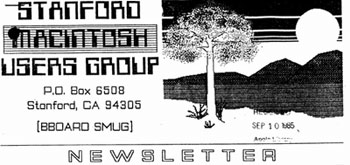talking history | syllabi | students | teachers | puzzle | about us
Making the Macintosh: Technology and Culture in Silicon Valley
http://library.stanford.edu/mac/
Produced by Alex Soojung-Kim Pang, Stanford University.
Reviewed June 2002.
Rather than trying to capture the entirety of the history of the Macintosh, as several recent books have done, Alex Soojung-Kim Pang’s Making the Macintosh wisely builds on the unique strengths of Stanford University Libraryís archive of documents and materials relating to the computerís origin, development, and promotion. Along with roughly two hundred archival texts and images, the site includes thirteen recent interviews (conducted by Pang and Wendy Marinaccio) with some of the principal players in the creation of the Macintosh.
Though any selection and arrangement of objects from an archive implies at least a modicum of editorial framing, for the most part Pang can rightfully claim that the site provides a representative set of sources and “allows the sources . . . to speak for themselves.” Editorial content consists of a short introductory page for each of the six main sections of the site and a brief, though helpful, guide to the most important materials in each section. As Making the Macintosh is still considered “under construction” (“Aren’t most Web sites?” a wag might respond), it would be helpful if in the future Pang significantly expanded those section introductions and document guides. By doing so he could claim a greater success in showing how social history can profitably engage the history of technology, as he promises on the “Historiographic Approach” page. Also useful would be a search engine (a standard feature of most online archives) and a glossary of technical terms.
For those not put off by the occasional encounter with such computer lingo, Making the Macintosh provides a fascinating insight into the goals and attitudes of the technologists and businesspeople who developed and promoted the Macintosh and the early adopters who cherished them. Of central importance was the idea that the Macintosh would be, as a 1979 manifesto by the guiding engineer Jef Raskin put it, for “the PITS”-the person in the street. This orientation was fairly radical at a time when computers were still synonymous with large, expensive calculating machines and when early “personal computers” such as the Altair and even the Apple II were adopted primarily by techies and knowledgeable hobbyists (or later, in the case of the IBM PC, by businesses).
From the section entitled “Early Mac,” which includes Raskinís manifesto (The Book of Macintosh), one can follow how this core populist notion influenced many of the later technical and marketing decisions, including the adoption of a one-button, easy-to-use mouse as an input device and the avoidance of large manuals filled with opaque acronyms. In light of those documents, the famous “1984” television advertisement that juxtaposed the supposedly liberating, truly personal Macintosh with the impersonal, Orwellian world of corporate computing becomes not the beginning of the Macintosh vision, nor a marketing sleight-of-hand, but a logical promotional expression for a technology produced by self-styled rebels with populist sentiments at heart and clear roots in 1960s Bay Area radicalism. The mission statements of the early Macintosh user groups furthered this legacy, uniformly trumpeting the importance of “mutual aid,” sharing, and “the business of giving away knowledge,” notions that persist in the open source and free software movements.
Daniel J. Cohen
George Mason University
Fairfax, Virginia

